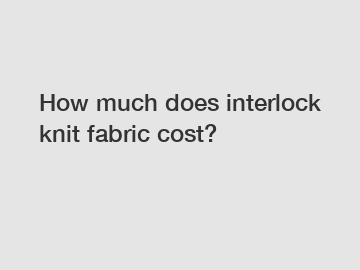How much does interlock knit fabric cost?
Intro:
Welcome to our blog, where we delve into the fascinating world of textiles! Today, we aim to demystify the cost of interlock knit fabric and equip you with valuable insights into this versatile and widely used textile. Whether you're a passionate fashion designer, an aspiring DIY enthusiast, or simply curious about the manufacturing process, understanding the cost factors of interlock knit fabric will help you make informed decisions and appreciate its true value.
1. Understanding Interlock Knit Fabric:

Interlock knit fabric is a double-knit fabric that exhibits great flexibility and softness, making it popular for a wide range of applications. Its unique construction involves two sets of needles and interlocking loops, resulting in a smooth face on both sides. High-quality interlock knit fabric offers excellent stretch and recovery, making it ideal for comfortable, form-fitting garments like t-shirts, dresses, and activewear.
2. Factors Affecting the Cost:
a) Fiber Type:
The type of fiber used in interlock knit fabric significantly influences its cost. Natural fibers such as cotton, wool, and silk tend to be more expensive due to their superior quality, breathability, and sustainability. On the other hand, synthetic fibers like polyester and nylon offer affordability and durability, making them a more economical choice.
b) Fabric Weight:
The weight or thickness of interlock knit fabric affects its cost as well. A heavier fabric requires more raw materials during production, resulting in higher manufacturing costs. Conversely, a lighter weight interlock knit fabric may be more budget-friendly, making it suitable for projects that require less structure.
c) Quality and Origin:
High-quality interlock knit fabric is often synonymous with higher prices. As with any textile, premium materials, excellent craftsmanship, and attention to detail contribute to the overall cost. Additionally, fabrics produced in countries known for their expertise in textile manufacturing, like Italy or Japan, may command a higher price due to their reputation for superior quality.
3. Pricing Range and Market Variations:
When purchasing interlock knit fabric, it's essential to consider the pricing range and understand market variations. Prices can range from as low as $5 per yard for basic polyester interlock to $30 per yard for luxury cotton interlock with exceptional softness and handfeel. Unique patterns, specialty finishes, and brand associations can also impact the cost, so it's wise to research and compare prices from different sellers before making a purchase.
4. Tips for Cost-Effective Choices:
a) Buy in Bulk:
Consider purchasing interlock knit fabric in larger quantities, particularly if you have multiple projects in mind. Many sellers offer discounts for bulk purchases, helping you save money in the long run.
b) Explore Online platforms:
The internet has revolutionized the textile industry, offering access to a multitude of online platforms where you can find interlock knit fabric at competitive prices. Online retailers often provide detailed product descriptions, customer reviews, and the convenience of doorstep delivery.
c) Fabric Composition:
Be mindful of the fiber content while selecting interlock knit fabrics. Blends containing synthetic fibers or a higher percentage of polyester can be more budget-friendly without compromising on durability or comfort.
5. Sustainability and Longevity:
When evaluating the cost of interlock knit fabric, it's essential to consider sustainability and longevity. Investing in higher-quality, sustainably sourced interlock knit fabrics may have a higher upfront cost but can pay off in the long run due to their durability, reduced environmental impact, and timeless appeal.
Conclusion:
Interlock knit fabric offers a world of possibilities for creative projects, and understanding its cost factors empowers individuals and professionals alike. By considering factors such as fiber type, fabric weight, quality, and origin, one can make informed decisions when purchasing interlock knit fabric. Remember, finding a balance between quality, price, and sustainability will ensure you obtain the best value for your investment while nurturing your love for textiles.
So, explore the options available, unleash your creativity, and let the interlock knit fabric elevate your designs to new heights! Happy crafting!
Want more information on cn88, fire resistant suppliers, fabric that is fire resistant? Feel free to contact us.

Comments
0